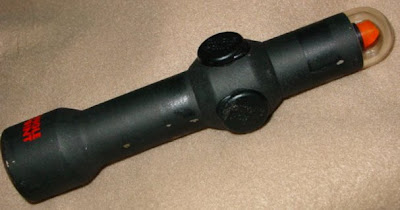The Stupid Springfield, Model of 1903
 |
| Photo courtesy Curiosandrelics |
The Springfield 1903 was a lousy rifle, in several respects, and a perfect example of why the government should not be left in charge of something as important as small arms development. It was a Mauser clone when better ideas were available. Its default, battle sight elevation was 547 yards. That was ridiculous, a triumph of theories once or twice removed from practical shooting. To obtain the right elevation for a more reasonable distance you needed to unfold the ladder sight to the 'up' position, in which it was fragile and awkward. The cartridge was a good one, the .30-'06, but the cartridge's creation was a tortuous process, in which the 1903 rifle needed to be revised when, in 1906, they finally figured out the ammunition thing.
Initially the Springfield had an integral bayonet, of the knitting needle type. Legend has it that the president at that time, Teddy Roosevelt, objected to this feature, breaking it to show it could be broken. Whether he broke it, or someone else did, he wrote a letter to the Secretary of War objecting to the design of the bayonet. The bayonet was changed to a detachable knife type. Fancy that, a president getting involved in small arms specifications! TR's eyesight was very poor, which may be why he did not notice the sight was absurd.
When an army rifle was needed for WWI, the Springfield was not available in sufficient quantity. It was built in federal armories, very slowly. The majority of Yanks went into battle with 1917 Enfields, which were available from private enterprise and thus abundant. The Enfields had vastly more practical sights; soldiers who got 1917's, instead of Springfields, got the better of the bargain.
A notable problem with Springfields of the WWI era was improper heat treatment of some receivers. The affected receivers were brittle and prone to shatter during firing. The problem was traced to poor procedures in manufacture. It is an awkward thing to have a war going on and have a significant problem emerge in the standard service rifle. That was the situation, though, in WWI.
In WWII, the Springfield was handed off to private contractor production and in the process acquired proper sights. The contractor-built 1903-A3, as it was called, had a peep sight. The A3 lacked in fit and finish, compared to the armory rifles, being a utilitarian model designed for speedy production. The barrel and receiver were Parkerized. Some machined parts of the original Springfield were eliminated and stampings used instead. This was the best of the Springfield breed, a rugged, no-frills battle rifle with a sight that was quick to use.
The 1903-A4 was a scoped A3. It was an outstanding shooter. Unfortunately, the scope was mounted atop the receiver, which prevented loading the rifle with clips. Cartridges needed to be pushed into the magazine one at a time. This retrograde progress was avoided by the Mauser ZF41, a contemporary of the 1903-A4. The German version used an extended eye relief scope, scout rifle style. You could load it with Mauser stripper clips, the principal advantage of a Mauser rifle, which of course the Springfield was, in all essentials.
The loading problem was also avoided by the Mauser sniper rifles with side mounts that positioned the scope to the left of the receiver. Germany fielded some Mauser sniper rifles with the scopes mounted in the way of loading, but they knew of at least two solutions that were better.
If we are to define an obvious identifier of progress in arms design in the century before last, and the early years of the last century, it was getting away from loading cartridges one by one in favor of clips, box magazines and belts. The scoped Springfield did an about face on progress and forced the rifleman to thread 'em in underneath the scope. Splendid! The scopes were not weatherproof and there were no backup iron sights.
In short, the Springfield rifle had various problems with it from the beginning of its production to the end, if we except the A3 as a fluke. It was not available in the quantities needed so long as it was government built, just as you would expect. The silly 547-yard sight and the utterly useless magazine cutoff switch, which converted the Springfield temporarily into a single shot rifle with the magazine of five shots "in reserve," show committee thinking at its worst.
Still, some men loved the Springfield, warts and all. Sci fi writer Robert Heinlein adored his and kept it handy just in case. I can think of better personal weapons, but love is never quite rational.
Gun & military writer H.W. McBride was more pragmatic. "But why don't they put a sight on it?"
Various gun pundits and gunsmiths took up the question of how best to give the Springfield the "sporter" treatment. It was shortened, lengthened, restocked and (of course) given new sights. Because it was, after all, a Mauser copy, ideas were abundant and results often mirrored European sporting rifles. (It is useless to maintain that a "Monte Carlo" stock is an American invention.)
The Springfield has two lessons to teach us. 1) You get better rifles sooner from private enterprise. 2) Designs, from any source, should be evaluated from the rifleman's point of view, not the theoretician's. We've learned the first lesson but I have my doubts that we've entirely mastered the second.


Comments
Post a Comment